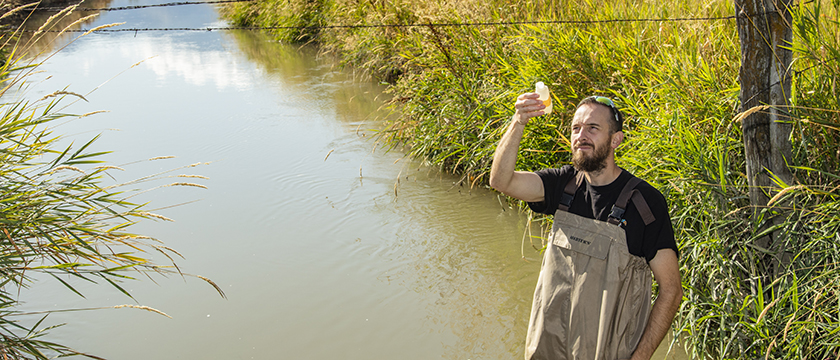

April 20, 2020By IA Staff Memeber
When David O’Bryant was let go from his call center job in 2014, he gathered his belongings, wiped down his desk, and walked away from the corporate high-rise with a smile on his face. “I was actually grateful,” he says now. “It was an opportunity for a fresh start.”
O’Bryant had struggled for ten years, working dead-end jobs and picking up construction gigs. He felt motivated to change career paths. “But I was full of self-doubt,” he says. “I’d been too intimidated to try college despite having a naturally analytic mind and a love of science.”
During those ten years, aquascaping—essentially building living, underwater scenes—became his one escape. He was fascinated by water chemistry. “I worked on them for twelve hours every day and basically became a basement-dweller,” he says. “When I lost my job, I wanted to figure out how to translate my aquascape knowledge into a profession.” He decided to apply to the Environmental Science and Management program at Utah Valley University. “I just ignored my fear of embarrassment and finally got the gumption to do it.”
As soon as he started his courses, he knew it was the right move. So much of what he’d studied independently to create the aquascapes came up in classes. In his second year, he met Professor Eddy Cadet, who has conducted a decades-long study on heavy metals in sediments in Utah Lake. O’Bryant was inspired. As a lifelong Utah Valley resident, he’s watched the population in the area grow—and the quality of the water in Utah Lake deteriorate. He wanted to learn more about the cause.
“The main focus of the project is to get a large picture of phosphate nutrients going into the lakes,” he says. “We’ve all heard of the poisonous spores that are lethal to pets and the elderly—in this case phosphorous is the pollutant causing the algal blooms. There are a lot of generators that are polluters, but we don’t know the largest source. That’s what we’re looking to study.”
Through the Turner Endowment for Engaged Learning, established with a generous gift from D. Clark Turner, Ph.D., and his wife, Pamela, in 2014, O’Bryant was able to hire a reliable team of student researchers. He ordered the necessary equipment, which he says, is a huge cost. “Without the Turners’ gift, this study would not exist—it would simply be impossible to do.”
Since receiving the grant, he’s been steadfast and diligent in his work. He spent the spring of 2019 cross-referencing other Utah Lake studies. From there, he created a map of various points from which to collect data. O’Bryant estimates that he and his team spend about 40 hours a week on the study. “We have 96 sites around the lake, and it takes about three days to sample them all,” he says. “I love it. I have a real appetite for this work.”
O’Bryant hopes that future students will continue the research for years after he leaves UVU. “The study has given us a chance to be researchers,” he says. “It’s immersive learning that provides real-life, practical experience that might actually allow us to mitigate some of the issues facing the lake.”
In December, O’Bryant will earn his degree along with a certification in Geographic Information Science. And now, with true confidence in his area of expertise, he’s working as an intern at Utah’s Department of Environmental Quality within the watershed protection division. He’s hopeful that after graduation the opportunity will turn into a full-time job. “I told my boss that I will stay on as long as he’ll have me,” he says. “I might be relatively new to the field, but I’ve gained so much experience already.”

